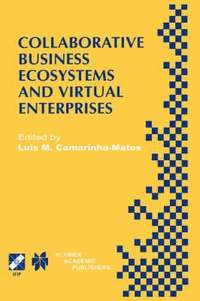
- Format
- Inbunden (Hardback)
- Språk
- Engelska
- Antal sidor
- 636
- Utgivningsdatum
- 2002-04-01
- Upplaga
- 2002 ed.
- Förlag
- Springer-Verlag New York Inc.
- Medarbetare
- Ifip Tc5/Wg5 5 Working Conference on Inf
- Illustrationer
- XX, 636 p.
- Dimensioner
- 243 x 158 x 36 mm
- Vikt
- Antal komponenter
- 1
- Komponenter
- 1 Hardback
- ISBN
- 9781402070204
- 994 g
Collaborative Business Ecosystems and Virtual Enterprises
IFIP TC5 / WG5.5 Third Working Conference on Infrastructures for Virtual Enterprises (PRO-VE02) May 13, 2002, Sesimbra, Portugal
- Skickas från oss inom 7-10 vardagar.
- Fri frakt över 249 kr för privatkunder i Sverige.
Passar bra ihop
De som köpt den här boken har ofta också köpt Bad Therapy av Abigail Shrier (inbunden).
Köp båda 2 för 2498 krKundrecensioner
Fler böcker av Luis M Camarinha-Matos
-
Emerging Solutions for Future Manufacturing Systems
Luis M Camarinha-Matos
-
Virtual Organizations
Luis M Camarinha-Matos, Hamideh Afsarmanesh, Martin Ollus
-
Collaborative Networks and Their Breeding Environments
Luis M Camarinha-Matos, Hamideh Afsarmanesh, Angel Ortiz
-
Balanced Automation Systems
Luis M Camarinha-Matos, Hamideh Afsarmanesh
Innehållsförteckning
Technical co-sponsors. Committees and referees. Foreword - Towards collaborative business ecosystems. Part 1: Reference models. 1. Reference Models for Virtual Enterprises; M. Tlle, et al. 2. Towards a Modeling Framework for Networks of SMEs; F. Biennier, et al. 3. Enterprise Engineering - The Basis for Successful Planning of E-Business; R. Jochem. 4. Handling the Complexity of IT-environments with Enterprise Architecture; T. Birkhlzer, J. Vaupel. Part 2: VE Creation Models. 5. A Dynamic Model of Virtual Organizations: Formation and Development; C. Lackenby, H. Seddighi. 6. Initiation of a Globally Networked Project: a Case Study; K. Visuri, et al. 7. In Search of the Right Partner; S. Field, Y. Hoffner. Part 3: Brokerage in Virtual Enterprises. 8. Brokerage Function in Agile/Virtual Enterprise Integration - A Literature Review; P. vila, et al. 9. A Framework for Broker Assisted Virtual Enterprises; C. Harbilas, et al. 10. Virtual Enterprise Broker: Processes, Methods and Tools; R. Meja, A. Molina. Part 4: Contract Management. 11. Managing Contracts in Virtual Project Supply Chains; H. Laurikkala, K. Tanskanen. 12. Managing Contractual Relationship in Virtual Organizations with Electronic Contracting; D. Burgwinkel. 13. Contract Management in Agile Manufacturing Systems; J. Barata, L.M. Camarinha-Matos. Part 5: Negotiation and Contracting. 14. A Proposal on Negotiation Methodology in Virtual Enterprise; T.Kaihara, S. Fujii. 15. Negotiation Protocol Characterization and Mechanisms for Virtual Markets and Enterprises; Y. Hoffner, et al. 16. A Conceptual Framework for B2B Electronic Contracting; S. Angelov, P. Grefen. Part 6: Workflow Management. 17. Towards a Cross-Organizational Workflow Model; K. Schulz, M.E. Orlowska. 18. Integrating a Workflow Engine anda Mof Repository to an Open Service Platform; C.R.M. Silva, et al. 19. Corvette: A Cooperative Workflow Development Experiment; K. Bana, et al. 20. Inter-Organizational Workflow Management in Virtual Healthcare Enterprises; T. Amin, H.K. Pung. Part 7: Knowledge Management. 21. Knowledge Acquisition for Building and Integrating Product Configurators; A. Felfernig, et al. 22. Towards Ontology-Based Smart Organizations; A. Maedche, P. Wei. 23. Using Ontologies in Virtual Brainstorming for Business Process Reengineering; A. Galatescu, T. Creceanu. Part 8: Order Planning and Optimization. 24. Distributed Enterprises Configuration: Orders Allocation within Networks of Firms; A. Hammami, et al. 25. Optimization Structures for Supply Chain Management; M.F. Carvalho, P.G. Furtado. 26. An Order Planning System to Support Networked Supply Chains; A. Azevedo, et al. Part 9: Enterprise Modeling Frameworks. 27. Developing an Unified Enterprise Modeling Language (UEML) Requirements and Roadmap; D. Chen, et al. 28. An UML-Based Meta-Language for the QOS-Aware Enterprise Specification of Open Distributed Systems; B. El Ouahidi, et al.
Du kanske gillar
-
Transformed
Marty Cagan
Inbunden


